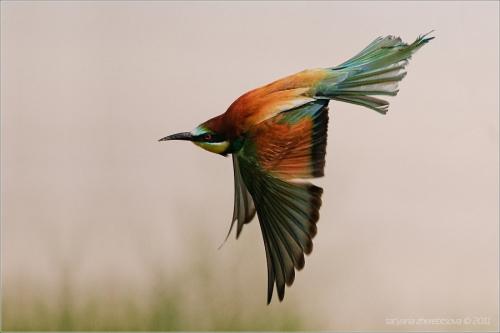Merops apiaster
 ~Photo taken by Tat’yanaZherebtsova in Автономна Республіка Крим, Ukraine~
~Photo taken by Tat’yanaZherebtsova in Автономна Республіка Крим, Ukraine~
The European Bee-eater (Merops apiaster) is a bird in the bee-eater family Meropidae. It breeds in southern Europe, parts of north Africa and western Asia, and occasionally in northwest Europe. It is strongly migratory, wintering in tropical Africa, India and Sri Lanka.
Like other bee-eaters, this bird is richly-colored and slender. It has brown and yellow upper parts, whilst the wings are green and the beak is black. It can reach a length of 10.6–11.4 in) including the two elongated central tail feathers. Sexes are alike.
Just as the name suggests, bee-eaters predominantly eat insects, especially bees, wasps and hornets which are caught in the air by sorties from an open perch. Before eating its meal, a European Bee-eater removes the sting by repeatedly hitting the insect on a hard surface. It eats some 250 bees daily. Lizards and frogs are also taken. Their impact on bee populations however is small because these birds eat less than 1% of the worker bees in the area in which they live.
These bee-eaters are gregarious, nesting colonially in sandy banks, preferably near river shores, usually at the beginning of May. They make a relatively long tunnel in which the 5 to 8, spherical white eggs are laid around the beginning of June. Both the male and the female take care of the eggs, which are brooded for about 3 weeks. These birds also feed and roost communally.
During courtship the male feeds large items to the female while eating the small ones himself. Most males are monogamous, but occasional bigamy has been encountered.
The call is a pleasant distinctive trill.
H/t Project Noah
~Eowyn

